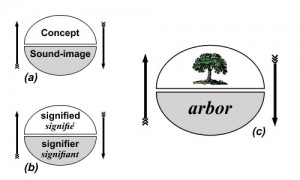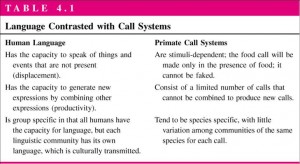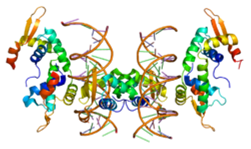Lesson Objectives:
- recognize language as a system of symbols and meaning
- identify the relationship between language and culture
- examine the relationship between language and power
- evaluate contemporary issues in language and identify using terms and concepts from the lesson
Language is the means by which humans symbolically represent, interpret and organize reality, and this makes language a central part of the human experience. According to Ferdinand de Saussure (1857-1913), one of the most influential linguists of the 19th century, ‘Without language, thought is a vague, uncharted nebula. There are no pre-existing ideas, and nothing is distinct before the appearance of language.’ Through language, people learn and share ideas and concepts and meanings and communicate with one another about the past, present and future. Language facilitates the development of social ties between individuals and serves as the foundation for group cohesion.
Language is learned and shared
Like culture, language is acquired through learning and sharing. While all humans are born with the cognitive capacity for language, language is acquired through socialization and interaction with others in a group. Since language is acquired through social interactions, it is embedded with social norms, values and ideas. An example of this is the use of the word ‘colored’ to describe people. The word communicates euro-centric values and hegemonic ideas that position light-skinned people as the standard, and those with darker skin as a deviation, having been ‘colored.’ Children who learn to use this word to describe people are also learning to evaluate, classify and reduce a wide range of diverse people according to skin color. The American Civil Rights movement and the African nationalist movements in the mid-twentieth century popularized different norms, values and ideas about identity that went far beyond skin color. New identity labels, or words, came into use, such as ‘African- American’ and ‘Afro-Carribean’, that emphasize equality, cultural heritage, nationalism, and diversity. (Asante 2007). Therefore, language both informs and is informed by society and culture.
Language is symbolic
Language is comprised of arbitrary associations between symbols and meanings. The associations are arbitrary because the meanings associated with the symbols are not inherent, they are ascribed (Saussure 1911) . Right now, for example, you are looking at a collection of arbitrary symbols called letters (or listening to a series of arbitrary sounds) which are arranged together to form words that are associated with meanings. There is nothing inherent to these symbols that indicate meanings. At some point in our lives, we both learned to associate these symbols with the same meanings, and through practice, we can now effortlessly translate the symbols and meanings without realizing we are doing it. It is through our shared knowledge of this collection of symbols and meanings, called English, that we are able to communicate ideas about the past, present and future.
Can you understand the symbols and meanings below?
مع نفس المعاني، ومن خلال الممارسة العملية، يمكننا الآن ترجمة جهد الرموز والمعاني دون أن يدركوا أننا نفعل ذلك. ومن خلال معرفتنا المشتركة لهذه المجموعة من الرموز والمعاني، وتسمى باللغة الانجليزية، ونحن قادرون على توصيل الأفكار عن الماضي والحاضر والمستقبل
Or these?
Δεν υπάρχει τίποτα που είναι συνυφασμένοι με αυτά τα σύμβολα που δείχνουν νοήματα. Σε κάποιο σημείο στη ζωή μας, εμείς οι δύο μάθει να συνδέσει αυτά τα σύμβολα με τα ίδια νοήματα, και μέσα από την πράξη, μπορούμε τώρα να μεταφράσει αβίαστα τα σύμβολα και τις έννοιες, χωρίς να συνειδητοποιούν το κάνουμε. Είναι κοινή γνώση μέσα μας αυτή τη συλλογή των συμβόλων και εννοιών, που ονομάζεται αγγλική γλώσσα, ότι είμαστε σε θέση να επικοινωνούν τις ιδέες για το παρελθόν, παρόν και μέλλον.
If you do not understand the system of symbols depicted in the above paragraphs, it is because you never learned to associate the system of symbols with concepts or meanings. This is what makes language a system of associations between concepts known as signs and a signifier which can be a sound or image (Saussure 1911). As Saussure points out, ‘Language is a system of interdependent terms in which the value of each term results solely from the simultaneous presence of others …’ What this means is that language is a system of relations, and signs derive meanings through the systems of multiple relations with other signs. For example, the concept ‘tree’ is not exclusively derived from the physical object that we perceive but also through a series of associations such as ‘timber’ (economy), ‘forest’ (ecology), ‘photosynthesis’ (biology), ‘wood’ (livelihood), ‘life’ (mythology), ‘branches’ (taxonomy), etc. All of these associations contribute to the meanings that form the concept that we know as ‘tree’. These associations vary cross-culturally according to the unique experiences shared within a community. The process of learning the system of relations is known as language acquisition. The acquisition of language enables people to effectively communicate, interact, and form a society.
When we address Structures in module four, we will consider the contribution of Saussure’s linguistic framework, one that is based on a system of symbols and meanings, in the development of the structuralist theoretical approach in the 20th century. For now, however, we will focus on the complexities of language and the role of language in society.
Visual and Auditory Language
Symbolic associations in language can be either visual (writing, body movement and sign language) or auditory (speech or music), and in many cases, the two forms can be combined to enhance or change meanings in the other. In some societies, for example, a verbally expressed declarative sentence such as ‘You have the key to the room’ is modified with a facial expression by raising the eyebrows to signal a visual cue which changes the meaning to: ‘You have the key to the room?’ Like auditory language, visual communication is also arbitrary, learned and shared. Placing the index finger and thumb together and fanning out the middle, ring and pinkie finger can communicate ‘Okay’ to one person when held high in the air. For someone who uses American Sign Language, the same hand signal can communicate ‘asshole’ when jerked at someone . The study of non-verbal communication through body movements, gestures, stances, and facial expressions is called kinesics.
Linguistics
Linguistics is the scientific study of human language with special attention to three specific areas: form, meaning and context. Language form investigates differences and meanings associated with structure, or grammar. Phonology is the study of sounds, and a phoneme is a sound that differentiates meaning. Phonetics is the study of what people mean with various sounds, and phonemics is the study of significant sound contrasts (phonemes) in a language.
Morphology is the study of forms in which sounds combine to form morphemes which are words and their meaningful parts.
 Morphemes are arranged into a lexicon which is all of the language’s morphemes and their meanings. Syntax is the arrangement and order of words in phrases and sentences. Semantics refers to the lexicon’s meaning system.
Morphemes are arranged into a lexicon which is all of the language’s morphemes and their meanings. Syntax is the arrangement and order of words in phrases and sentences. Semantics refers to the lexicon’s meaning system.
Signed Languages
Sign language is a lexicon of signs and meanings expressed visually through the precise movement of hands, arms, and facial expressions. American Sign Language (ASL) is considered a language because the language is embedded within the deaf cultural community. Other forms of signed language, such as Cued Speech and Signed English, are comprised of a series of gestures that are analogous to auditory languages. Cued Speech assigns a gesture to each phoneme, and Signed English assigns a gesture to each morpheme..
Both Cued Speech and Signed English are comprised of visual signals that act as substitutes for the auditory symbols used in verbal languages. American Sign Language is considered a ‘natural’ language, because ASL reflects the norms, values and ideas of the ‘deaf community’ and this makes ASL an important part of deaf culture. The award-winning documentary, Sound and Fury (2000), sheds light on the significance of American Sign Language as a deaf family struggles over their young daughter’s desire for a cochlear implant which is a surgically-implanted auditory device that provides a sense of sound.
Primatologists have also used ASL as a research tool to investigate the language capacity of non-human primates. Recent research has shown that some non-human primates are capable of learning and using American Sign Language. The first non-human primate to learn ASL was a female named Washoe (Carey 2007), and since that time several other chimpanzee have learned sign language. Many chimps exceeded 100 signs and learned to combine signs to form rudimentary sentences and produce new words. This research also revealed that chimpanzees engaged in characteristically human behaviors such as swearing, telling lies, joking, and trying to teach language to other chimpanzees (Fouts 1997). In 1966, Penny Patterson conducted research with a 250lb gorilla, named Koko, who learned to use more than 400 signs on a regular basis. Koko also demonstrated that non-human primates are capable of displacement, communicating about things that are not present, a trait that was previously believed to be limited to human primates.
Language is Human
The capacity for language is often cited by anthropologists as the hallmark difference between humans and non-human primates. Without specialized training, non-human primates communicate by using call-systems, a limited number of vocalized sounds emitted in response to stimuli. Unlike humans, non-human primates do not combine call systems to generate new meanings and the vocal tracts of apes do not allow for the development of speech.
Language and Human Evolution
Language development has provided a tremendous adaptive advantage to humans by serving as a means to 1.) facilitate learning, 2.) store an immense amount of information through extended periods of time, and 3.) communicate about things that are not present (Kottak 2012). Evolutionary anthropologists suggest that the human capacity for language emerged from a mutated gene called the Forkhead box protein P2 or FOXP2 approximately 150,000 years ago (Paulson 2005). Through time, human language developed into several thousand distinct lexicons, both living and extinct, that are comprised of complex systems of symbols and meanings.
There are different perspectives on the relationship between linguistic differences and cognitive development in humans. Noam Chomsky (1957) has argued that linguistic and cognitive processes in humans are similar, and that all languages have a common structural basis called a universal grammar. According to Chomsky, people can learn a foreign language because they translate the ideas and meanings of one language into another within a universally-shared grammar.
Edward Sapir and his student, Benjamin Whorf, have argued that language shapes the way people interpret reality and different languages lead to different ways of thinking and seeing the world. This is referred to as the Sapir-Whorf hypothesis (1931). Culture Theory suggests that language shapes, but does not restrict, thought because cultural changes can produce changes in thought and language. In the video below, Dr. Arnold from Sinclair Community college in Ohio describes the different theories for the relationship between language and culture.
Language in Society
Socio-linguistics is the scientific study of the relationships between language variation and social contexts in the past and present (Romaine 2000; Trudgill 2000). Language change through time can also reflect historical changes, and linguistic similarities and differences can shed light on the historical relationships between different groups of people. Socio-linguistics has also shed light on the ways that social and cultural contexts inform meaning in extremely complicated ways. This animation by Steven Pinker describes differences in linguistic meanings in the social context of circumstance, ambiguity and innuendo as he reveals the complexity of language and the capacity for misunderstanding when people fail to ‘read between the lines.’
By learning and sharing symbolic associations with meanings, human groups organize and interpret reality in ways that reflect shared norms and values. While shared language can forge social bonds among people, language difference can divide people by excluding those who communicate differently. Research on linguistic variation has shown that social differences and hierarchies are expressed and reinforced by differences in the ways that people use language. In many ways, language can reinforce inequality by codifying differences in social status, class, ethnicity, race, gender, education and other forms of inequality (Lakoff 2000; Labov 1972a). People also use and evaluate speech within social, political, and economic contexts (Kottak 2012). What this means is that people ascribe meanings to languages and the way languages are used according to different social, political and economic circumstances. In Morocco for example, many urban and educated mothers choose to speak to their children in French, the former colonial language rather than one of the indigenous Amazighe languages or even the predominant Arabic language (Sadiqi 2005). This is because French is symbolically associated with power; it was the language of the former colonial French government and it continues to be the primary language used in schools, government and urban cultural centers. Because of this, French is associated with modernity, and speaking French offers greater social, political and economic opportunities than the indigenous languages. Like many parents in post-colonial states, a large number of urban parents in Morocco choose to speak to their children in the language of the former colonial oppressor rather than the indigenous language spoken by their family’s social group.

photo by Matt Rourke (AP) published on http://www.msnbc.msn.com/id/13272368/ns/us_news-life/t/philly-officials-warn-eatery-english-only-sign/
Pierre Bourdieu (1982) refers to this linguistic hegemony as a type of symbolic domination, because even people who are not included in the dominant language social group oftentimes accept its authority and prestige. When the dominant language provides access to resources and opportunity, it becomes a type of symbolic capital because it can be used as leverage to acquire or increase wealth (Bourdieu 1984; Gal 1989; Lakoff 2000). This is particularly the case in areas such as the United States where education and job opportunities are primarily ‘English only’, and people who do not share the English language are excluded from those opportunities. Even within a society that appears linguistically homogenous, such as the English-speaking community in the United States, variations in pronunciation, word use and grammar can reflect and reinforce social inequalities (Labov 1972; Bloch et al 1975) . This becomes evident when educational institutions and social groups emphasize ‘proper’ language use which invariably excludes minority variations of the dominant language such as the marginalization of Black English Vernacular (BEV) in the United States as well as the social stigmas tied to accents and word-usage in the southern states. What socio-linguistic relationship is expressed in the FOX News report below?
To watch an excerpt from the PBS documentary, ‘Do you speak American?’ that addresses the Oakland Ebonics controversy, click here.
If we examine the linguistic history of the English language, it becomes difficult to identify ‘proper’ English, because the language has changed dramatically as it has been learned and shared by countless people through several historical epochs and geographical expanses. (For more information, visit this NSF website.) This is because, like culture, language is both dynamic and adaptive. When symbolic domination causes subordinate languages to disappear however, linguistic diversity as well as cultural diversity is reduced.
Language Diversity and Loss
Of approximately 7,000 remaining languages, about 20% are currently endangered (Maugh 2007). As linguist K. David Harrison states, ‘When we lose a language, we lose centuries of thinking about time, seasons, sea creatures, reindeer, edible flowers, mathematics, landscape, myths, music, the unknown and the everyday.’ In his book, When Languages Die (2007), he notes that the world’s linguistic diversity has been cut in half since European colonial expansion was initiated 500 years ago. Research by linguistic anthropologists can help protect endangered languages, such as this research by The Living Tongues Institute:
Research has also shown that there is a positive correlation between linguistic diversity and biological diversity. Areas with high linguistic diversity are located in areas with high biodiversity (Stepp, Casteneda, and Cervone 2005). The relationship between language, culture and the environment is referred to as biocultural diversity. We will further explore the relationship between language and the environment in module four within the Environment segment.
What Did You Learn?
Test your knowledge with this quiz.
Your Score:
Your Ranking:
Discussion 1pt: Consider the significance of language in culture and society. Using what you have learned in this module and the readings, consider the cultural significance of American Sign Language (ASL) and Black English Vernacular (BEV). What are the implications of analogous sign languages such as Cued speech, Signed English and Standard English for the deaf cultural community? Would you consider the cochlear implant, training in ‘proper’ English, or English-only policies a type of symbolic domination by those in power or are they simply a means of empowering marginalized people by increasing access to a type of symbolic capital? There are no right or wrong answers, yet it is important to explain the reasoning for your perspective by using the anthropological terms and concepts introduced in this lesson.
When you complete the discussion, move on to What is Anthropology?





